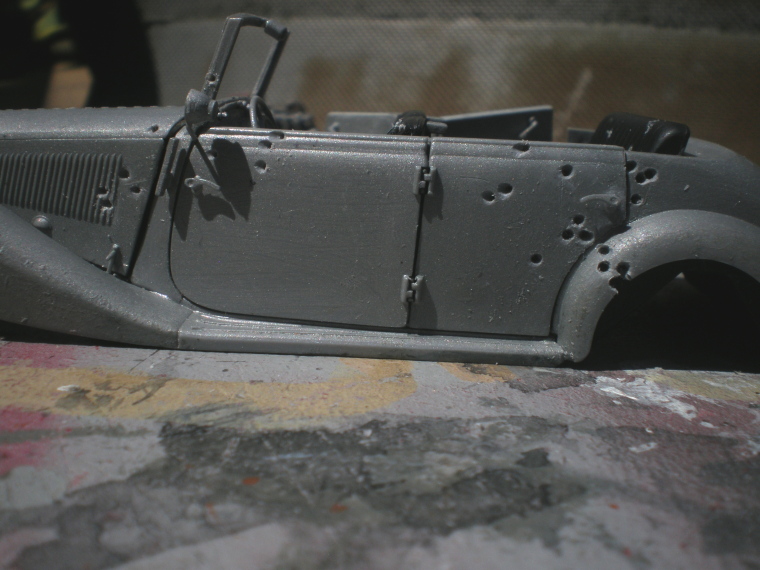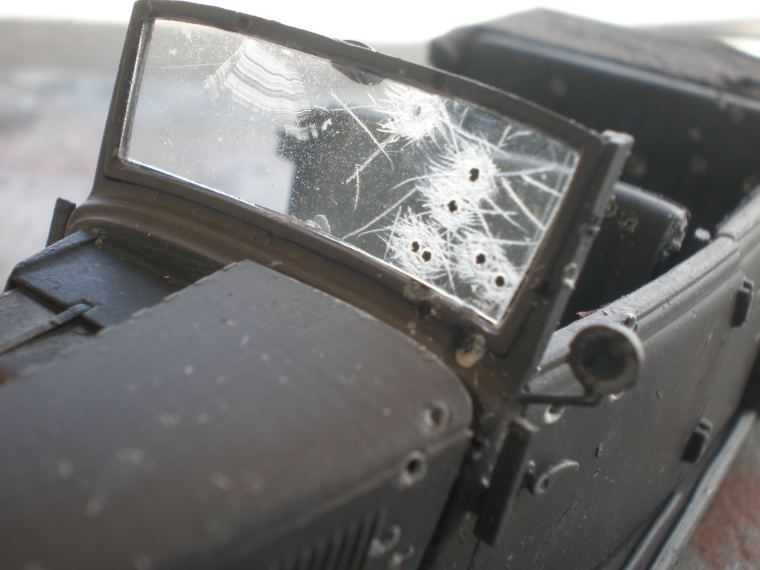Thanks gents…
Jerry – crossed my mind too but Heydrich’s ride was a stretch limo compared to this jalopy. Although thinking about a variation…if these officers were driving at night and pulled over for a comfort stop when ambushed…would Darren let me call it A Sh*t in the Dark?
Bob – thanks for spotting, looks like that ICM set is the only one especially clothes-wise given it’s a summer setting. Now that I’ve searched a bit too I like Corsar’s Red Army Medical Sister (CR35006) in a skirt letting loose with a burp gun – cute, never seen her before but alas this is looking like an aftermath dio. Maybe I can Russify some other-nationality partisan types as extras.
Cheyenne – I guess now I’ll have to put my money where my mouth was on your thread recently, and attempt shattered glass in the windscreen…
Stef – maybe it needs more damage - a second shooter…from a grassy knoll perhaps (don’t get me started, I know what happened & it wasn’t from there), because I’m discovering chassis-to-body fit problems now.
So now to do something/anything with the folded tilt, as seen in the first image at the top of this thread in the bottom right corner, looking like some miniature constructivist sculpture - assumed to be a fitted material cover intended to protect the concertina’d rig. I’m doing this in some detail in case it helps others with a more realistic representation of fabric & material in general.
Step 1 – assembling the entire Acrylic Paints Inventory (because every colour/shade/tone in the visible spectrum is here), a worm-let of pigment from each tube seasoned with a dab of Tamiya X21 Flat Base to take away the sheen when dry…maybe a sheen would be more correct (water-proofed material?) but in photos it can look seriously unrealistic.

Step 2 – Add water to taste and stir into a thickish darkish nameless colour. My point being there’s rarely any such thing as “black” (Colour Theory 101) – at least at 1/35th scale. At its darkest it’s usually a dark blue/green/brown (Tamiya’s enamel “Rubber Black” is dark blue-green, used here on the seats as a base coat) and even if the real item started out as near-black, after a couple of years in Russia it’s going to be faded/dirty/dusty. The final shade can always be adjusted later with a wash of paint and/or pastel dust. Besides, student-quality acrylic paints dry a couple of shades darker than when wet so there’s no point obsessing about colour-accuracy yet.

Step 3 – laying 2 sheets of plain 2-ply tissue over the mix and gently pressing with a soft brush until it soaks through, then peeling away and allowing to dry.



(hey it’s high summer here so I can do this for quick-drying)
Step 4 – Releasing The Blob – wrinkling/creases have occurred naturally, enhance-able by re-soaking with clean water and gently working it around with a soft brush.

Step 5 – The blob’s big enough so that if the first attempt failed/tore, I had enough left for another try. Cutting to shape and gluing to the kit's plastic tilt with pva/Elmers - only a very thin layer necessary, otherwise it’ll soak right through and leave shiney patches on the surface.

Step 6 - test-fit…


Needs fine-tuning - and bullet damage - but it’ll do for now.
Maybe this technique has potential for individual figures (particularly large-scale); even a matt/flat topcoat can leave crease-edges unrealistically reflecting light because the paint’s always being applied to a smooth plastic surface. The grain of a single 2-ply tissue breaks up that smoothness – maybe even 1-ply for ultra thin-ness, and although very delicate to handle while wet the acrylic paint will hold it together when dry. A large “bolt” of dried “fabric” could be then tailored to fit arms, legs, torso etc., re-wetted to make it pliable and applied with a thin solution of Elmers. When dry again, adjusting colour-washes can always be applied if necessary. Then open a Bespoke Emporium for the Smaller Man.
Yeah I know it, shouldn’t be mixing my drinks.
Next time: Murk-y paint-job.









































































